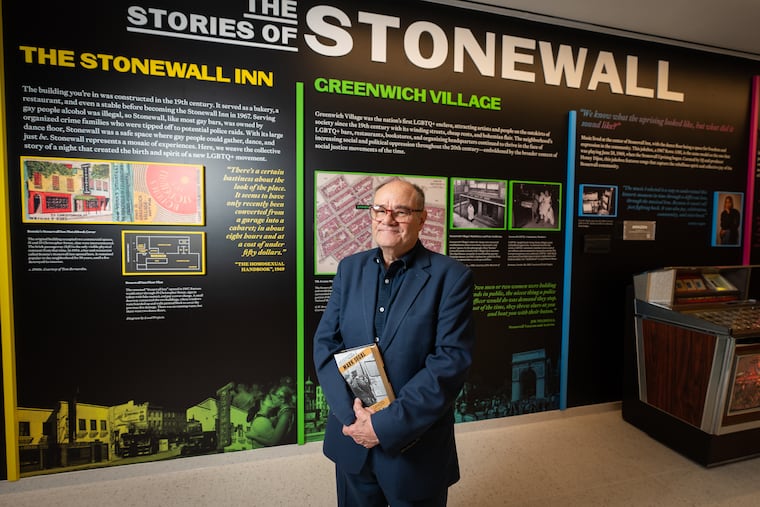This Philly icon was at Stonewall. Now he’s part of its new memorial.
Mark Segal didn’t realize it back then, but a June 1969 police raid at the bar was a turning point in LGBTQ history. It also launched his own life of activism.

At 73, Mark Segal has seen some things.
When he was 18 and newly graduated from Germantown High School, he went to a popular gay dive bar on Christopher Street in New York City’s Greenwich Village. Segal was in the back — grooving along with a couple hundred people to “Let the Sunshine In” by the Fifth Dimension — when suddenly the overhead lights blinked on and off, signaling yet another police raid.
Cops burst inside and smashed up the bar, throwing bottles around. “My first thought was, ‘Oh my God, I had better call the police,’” Segal recalled. “But it was the police who were doing it.”
It was June 28, 1969. The establishment was the Stonewall Inn.
At the time, same-sex relations were illegal in every state but Illinois, and cops often raided and shut down hangouts like Stonewall, arresting patrons. But what happened that night in the Village was no ordinary raid.
There are differing accounts, but at some point, patrons began resisting arrest, and fought back against the police. A riot ensued.
The mob forced the police to retreat into the Stonewall Inn, where they barricaded themselves inside. Finally, at 4 a.m., the scene quieted. But it was not over.
Before Segal went back to the YMCA where he was staying, a friend of his, Marty Robinson, handed Segal a box of chalk and told him to write on walls and sidewalks: “tomorrow night Stonewall.” It was a signal to the city’s gay community that what had happened that night was not over.
Over the next six days, members of the LGBTQ community, along with Village residents, returned to Stonewall, organizing and spreading information — and, in the process, helping to kick off the modern gay rights movement.
Segal didn’t realize it back then, but that night was a turning point in LGBTQ history.
It also launched his own life of activism.
These days, Segal is 73, happily married to the man of his dreams, and the publisher of the Philadelphia Gay News, an award-winning weekly paper based in South Philly. For years, his memories of what happened at Stonewall, which President Barack Obama declared a national monument in 2016, were in his rearview mirror.
Then, two years ago, Diana Rodriguez, cofounder and CEO of Pride Live, a nonprofit dedicated to LGBTQ advocacy that secured a lease to the Stonewall Inn site, began asking him questions about what happened all of those years ago. She wound up inviting him to help curate the history for the Stonewall National Monument Visitor Center that opened June 28.
Segal “provides a firsthand account of history,” Rodriguez told me. “He tells the story of how he came up with however much money he had in his pocket and how he took the subway here to the Village, looking for community, looking for people who were like him.”
Saying Segal is honored to be a part of the new Stonewall memorial would be a gross understatement. For the LGBTQ community, “this is hallowed ground, just like the Liberty Bell or Independence Hall is for anybody who feels patriotism towards the United States,” he said. “If you’re going to look at the gay movement and pay homage, you’re going to Stonewall.”
For the LGBTQ community, ‘this is hallowed ground.’
I’d never been. So, when he invited me to New York City to check out the visitor center before it officially opened to the public, I jumped at the opportunity. It’s one thing to read about what happened 55 years ago, but it’s a whole other thing to be at the site where it all began with an actual eyewitness. Besides, I’m a huge fan of Segal’s and the work that he’s done with the Philadelphia Gay News over the years. I’m thrilled to see him get this kind of national recognition.
» READ MORE: In your presence, I feel like I can breathe
I arrived not fully understanding that the Stonewall Inn at 53 Christopher St. is actually a private business that’s still in operation.
The Stonewall Visitor Center, located immediately next door at 51 Christopher St., is bright, airy, and inviting. As I walked through the main entrance, the first thing I saw to my left was a huge wall covered with information about the Stonewall uprising and the Stonewall Inn. I took in the words, “Here we weave the collective story of a night that created the birth and spirit of a new LGBTQ+ movement.”
I read brief recollections about what happened and various quotations from participants such as Stormé DeLarverie, who is described as a “butch lesbian who scuffled with police outside.” According to the visitors center, DeLarverie described what happened “as a rebellion, it was an uprising, it was a civil rights disobedience — it wasn’t no damn riot.”
At one point, Segal posed for photos in front of a now bricked-over doorway, through which he had entered into the bar that fateful night. There’s even a 1967-era jukebox loaded with songs from back then.
Together, Segal and I walked to where the dance floor had been, and where he’d been enjoying himself only moments before cops burst onto the scene. In that moment, the ensuing decades drifted away. I could imagine the young, idealistic man with the longish brown hair who’d been swaying to the music, not realizing all that was about to happen — both to him and the LGBTQ community.
Let’s all hope that Stonewall and the new visitor center serve as a permanent reminder to America of the importance of one day truly living up to the ideals upon which our nation was founded.